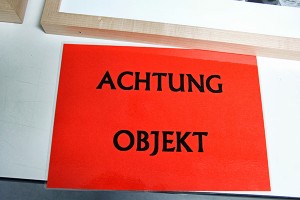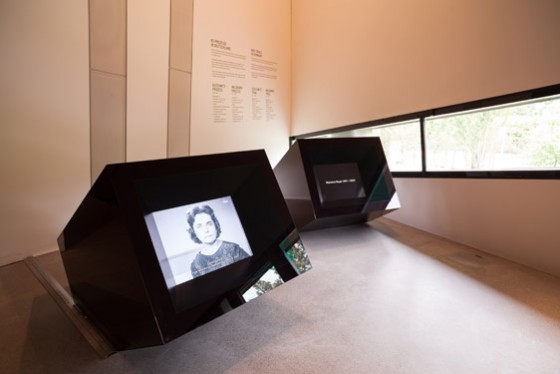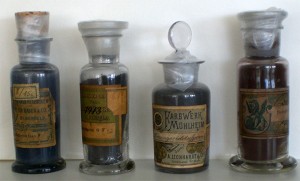
A label in our restoration studio to prevent anyone from inadvertently touching or removing an object.
© Jewish Museum Berlin, photo: Gelia Eisert
My story actually begins with a visit to the museum. It draws the curtain slightly on the making of an exhibit that’s usually veiled from the eyes of visitors. But first I have to tell another story, in order for both – one current and one from the past – to have meaning.
A little trail runs through our permanent exhibition pointing to David Friedländer (1750-1834). → continue reading
A New Space for the Auschwitz Trial in the Permanent Exhibition
Last October I wrote a blog post about Memorandum, a Canadian documentary film about the Auschwitz trial in Frankfurt (1963 – 1965). An excerpt of this film has been part of our permanent exhibition for a number of years already. We observed that the film clip elicited a much more intense response from visitors to the legal proceedings of Nazi criminals in Frankfurt than did other forms of media, such as photographs or audio clips. For this reason, documentary film material has been made the central focus of the newly designed area of our permanent exhibition.

“My husband was very accurate, indeed, but […] I can’t imagine all this,” said the wife of Auschwitz perpetrator Wilhelm Boger to NDR journalists
© Jewish Museum Berlin, photo: Alexander Zuckrow
Just a few days ago we re-opened this space with the title “On trial: Auschwitz/Majdanek.” In order to convey how the Auschwitz trial in Frankfurt shaped and changed public attitudes towards the past in Germany, we now show a variety of excerpts from contemporary television coverage. In the international coverage of the trial, groundbreaking questions were raised about the way the National Socialist era was officially and publicly dealt with. → continue reading
A museum has a thousand objects in its possession, but sometimes just the right one is missing! Last winter when I was preparinga new showcase in the permanent exhibition on the Nobel Prize winner Paul Ehrlich, I didn’t have enough pieces to create a coherent presentation for the exhibit.
I wanted to illustrate Paul Ehrlich’s achievement in the field of medicine with documents and paraphernalia from his work, but didn’t find any appropriate objects in our collection. Nonetheless this significant scientist was to appear in our exhibition. He developed a cure for syphilis, founded modern cancer research, and brought many important, trendsetting research results to light.

Jars of dye that Paul Ehrlich needed for his famous experiments with dye, Paul Ehrlich Institute, Langen
© photo: Christiane Bauer, Jewish Museum Berlin
So I began to search for suitable exhibit pieces and found my way to Hessen: both the Paul Ehrlich Institute in Langen and the Georg Speyer House in Frankfurt – Paul Ehrlich’s last and most significant workplace – have an impressive store of items related to his work and influence. But how to bring these objects to the museum in Berlin? → continue reading


